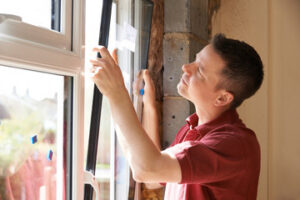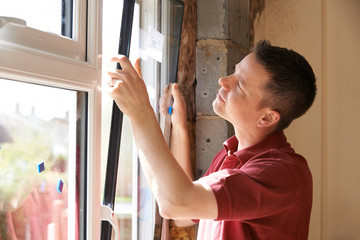Window Replacement Lakeway can elevate your home’s curb appeal and comfort while improving its energy efficiency. Learn about the different window types available to best meet your needs and budget.
Leaky windows that allow moisture to build up and damage the frame can lead to mold growth and serious health issues from spore inhalation. Experts recommend replacing them as soon as you notice any problems.
You can choose from many types of windows when it comes time to replace old ones. Each type offers unique benefits and looks that can help elevate the style of your home.
The window styles available in today’s market include casement, awning, slider, and double-hung windows. Each has its own operating mechanisms and benefits. The best choice for you will depend on your preferences and the type of space that each window will be used in.
Bay, bow, and picture windows add a spacious feel to rooms and can offer expansive views of the outdoors. These are ideal for entryways and living spaces where you want to let in plenty of natural light.
Awning and casement windows are easy to open. They can be opened wide to allow for fresh air and are great choices for bathrooms and basements, where ventilation is important. Slider windows are a good choice for kitchens, as they can also open easily and provide plenty of ventilation.
If you prefer a more traditional look, single-hung windows are the way to go. These are opened by sliding the bottom window panel over the stationary upper sash. They are the most popular type of replacement window and come in a variety of sizes, finishes, and features.
Some homeowners like to customize the appearance of their new replacement windows by adding grids, called muntins, or mullions. Others prefer a cleaner aesthetic and may choose a window without them.
When it comes to energy efficiency, you can’t go wrong with vinyl replacement windows that are certified by Energy Star. These windows can make a significant difference in your heating and cooling costs.
Another option is to install “pocket” replacement windows in your existing frame opening. These are slid into the opening by a professional window contractor. They can be installed in a range of window frames, from wood to aluminum. You can even use them to update a single-hung window to a newer style. The key to pocket installation is proper measurements of the existing frame opening.
Installation
When window replacement is completed, it will improve the appearance of your home. It will also increase its energy efficiency by preventing drafts and keeping the temperature inside your home stable. Window replacement can be a complex project, but with proper planning and knowledge of the different types of window installation, homeowners will be able to enjoy a smooth renovation process.
There are two main types of window replacement installation: full frame replacement and pocket replacement. Full frame window replacement is the more involved of the two options, as the existing windows are removed down to the studs and new windows are installed into the opening. This method of window installation allows contractors to inspect and repair areas where rot or water damage have occurred, which may be hidden behind the interior trim. It is a more costly option, but it offers the most durability and long-term performance.
Pocket replacement, also known as retrofit installation, is the less-expensive of the two options and allows homeowners to keep their existing windows in place. This type of window replacement involves a smaller job and can be done more quickly than a full frame renovation. However, it is important to note that the existing window may be prone to leaks due to age or poor installation, so this type of replacement should be considered carefully before choosing.
During the installation process, there are several things that can go wrong, even with the most experienced contractor. If the proper steps are not taken before starting, it can lead to delays and extra costs. For example, it is important to protect areas around your windows with drop cloths and other materials to avoid damaging landscaping or causing unnecessary mess. Also, proper scheduling will help ensure that your project stays on schedule and weather concerns are considered.
Before beginning the installation process, your contractor will need to carefully measure the opening of your existing window to make sure that the new windows are an accurate size. To do this, they will remove the sashes from your existing windows and measure the height and width of the opening. It is best to measure the height from the top of the head jamb in three places, and the width at the left, middle, and right side of the existing frame. This will allow your contractor to order the correct size of window for your installation.
Energy Efficiency
Energy-efficient windows reduce heat loss, helping your HVAC system keep a stable temperature. In addition, they help prevent warm and cool air from escaping your home. They also reduce noise and provide UV protection, which protects carpets and furniture from fading. Many newer window styles also provide security, such as those that lock or cannot be opened from the outside.
When choosing new windows, look for the ENERGY STAR label to make sure they meet federal energy efficiency requirements. The number of panes and type of filler gas, such as argon, are important factors. Look for Low-E coatings that both reflect radiant heat and block UV rays. Also, consider the frame material and style: Aluminum frames are poor insulators while vinyl and fiberglass are better.
You can also find windows with a lower U-factor and SHGC rating, which helps you save money on your heating and cooling costs. These features usually come at an extra cost, but can be a good investment over the long term.
It typically takes about 70 years to recoup the cost of new windows through energy savings, according to Wasielewski. This is well beyond the average window’s warranty and practical life expectancy, as well as most homeowners’ own lives.
The amount of time it takes for new replacement windows to pay for themselves in energy savings is even greater if you factor in the embodied energy of the windows. This is the energy used to manufacture and install the windows, as well as the energy they will use throughout their lives.
Many local utility companies and state governments offer energy-efficiency rebates for homeowners who replace their windows. You can find detailed information on these programs and eligibility criteria online.
The best time of year to do a window replacement project is in the late spring and summer, when temperatures are mild. This makes it easier for your HVAC system to keep the house comfortable while the windows are being installed and replaced. It is also less expensive than doing it in the winter or the fall. The weather can also impact the project’s timeline and overall cost, as rain or snow can affect both the workability of tools and the quality of the installation.
Maintenance
Window replacement is a significant investment that requires proper maintenance to ensure optimal performance and longevity. A seasonal maintenance schedule should include cleaning glass and frames, lubricating moving parts, and checking weather stripping to prevent air leaks. This maintenance routine will extend the lifespan of new windows and help homeowners save on energy costs.
If a homeowner notices that their windows are not functioning properly, it is important to address these issues promptly. Window problems that are ignored can cause damage to the home’s structure and may lead to expensive repairs. These problems can also lower a home’s energy efficiency and comfort.
Moisture issues are common and can show up as fogging between double pane windows or as condensation on the window’s frame. These issues can be caused by moisture entering the glass from outside or by air blowing through cracks in the glass and frame. Moisture issues can be corrected with proper sealing and insulation techniques, but in severe cases it might be necessary to replace the window.
Drafts and leaks are another common problem that can significantly decrease a home’s energy efficiency. Leaking or drafty windows allow cold air to enter the home and force the air conditioning system to work harder to keep a comfortable temperature. These issues can be resolved with the help of a professional by addressing the seals around the window and repairing or replacing any damaged components.
A regular inspection of the window should include a look for signs of damage to the frame, wood rot, rust, and discoloration. It is also a good idea to check the functionality of the windows by examining for any loose screws or hinges. It is also a good idea to examine the window screens for holes or tears that can allow pests to enter the home.
Homeowners should also make sure that their windows can open and close easily to provide ventilation and reduce the load on the air conditioning system. Finally, it is a good idea to inspect the windows for warping or swelling due to high temperatures. If these issues are addressed quickly, it can prevent further damage to the window and improve a home’s energy efficiency.

